How to spot scams like "We noticed a login from a device you don't usually use"
Phishing/ScamAlso Known As: We Noticed A Login From A Device You Don't Usually Use spam
Get free scan and check if your device is infected.
Remove it nowTo use full-featured product, you have to purchase a license for Combo Cleaner. Seven days free trial available. Combo Cleaner is owned and operated by RCS LT, the parent company of PCRisk.com.
What is "We noticed a login from a device you don't usually use"?
"We noticed a login from a device you don't usually use" refers to an email spam campaign - a mass-scale operation during which thousands of deceptive emails are sent. The letters distributed through this campaign are disguised as notifications concerning a suspicious device having been used to sign into the recipients' email accounts.
The goal of these scam letters is to trick users into exposing their email account log-in credentials (i.e., email addresses/ usernames and corresponding passwords) by attempting to log in via a phishing website.
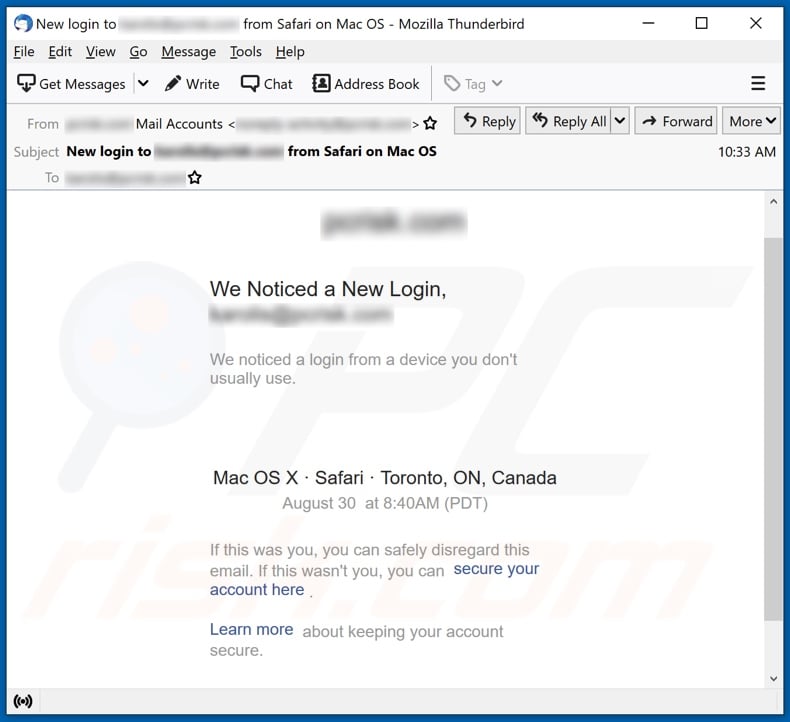
"We noticed a login from a device you don't usually use" scam email in detail
The "We noticed a login from a device you don't usually use" scam emails (subject/title "New login to [recipient's email address] from Safari on Mac OS"; may vary) inform about a dubious log-in through a previously unused device. The fake notifications then go on to list details of the alleged sign-in to the recipient's email account.
The letters instruct to disregard them if it was indeed the recipient who had logged into their account. However, if it was not them - the emails tell the recipient to click "secure your account here".
Despite how legitimate these emails may seem, it must be emphasized that they are fake. Therefore, no unauthorized access to the recipients' accounts has occurred. Furthermore, the link provided in these letters leads to a phishing website disguised as an email account sign-in page.
Sites of this type operate by recording the data entered into them. Therefore, recipients may have their email accounts stolen by attempting to sign in through the website promoted by the "We noticed a login from a device you don't usually use" scam letters.
Scammers target emails as they are typically connected with (e.g., used to register) other accounts, platforms, services, and so on. Therefore, through stolen email accounts - cyber criminals may gain access/control over content associated with them.
To elaborate on how this can be abused, communication accounts (e.g., emails, social networking, social media, messengers, etc.) can be used to ask the contacts/friends for loans - under the guise of the genuine owner. Alternatively, these platforms can be employed to proliferate malware by sharing malicious files or links.
Finance-related accounts (e.g., online banking, money transferring, e-commerce, digital wallets, etc.) can be used to make fraudulent transactions and/or online purchases. In summary, by trusting the "We noticed a login from a device you don't usually use" scam emails, users can experience severe privacy issues, financial losses, and identity theft.
| Name | We noticed a login from a device you don't usually use Email Scam |
| Threat Type | Phishing, Scam, Social Engineering, Fraud |
| Fake Claim | Scam emails claim that a previously unused device has logged into the recipients' email accounts |
| Symptoms | Unauthorized online purchases, changed online account passwords, identity theft, illegal access of the computer. |
| Distribution methods | Deceptive emails, rogue online pop-up ads, search engine poisoning techniques, misspelled domains. |
| Damage | Loss of sensitive private information, monetary loss, identity theft. |
| Malware Removal (Windows) |
To eliminate possible malware infections, scan your computer with legitimate antivirus software. Our security researchers recommend using Combo Cleaner. Download Combo CleanerTo use full-featured product, you have to purchase a license for Combo Cleaner. 7 days free trial available. Combo Cleaner is owned and operated by RCS LT, the parent company of PCRisk.com. |
Spam campaigns in general
"MoneyGram Email Scam", "New Fax Received", "System has detected irregular activity", and "Email Cloud Scam" are some examples of phishing spam campaigns. The deceptive emails are usually disguised as "official", urgent", "important", and similar.
Aside from phishing and other scams, spam letters are also used to spread malware (e.g., trojans, ransomware, cryptocurrency miners, etc.). Due to the relative prevalence of spam mail, it is strongly advised to exercise caution with incoming emails and messages.
How do spam campaigns infect computers?
Systems are infected via malicious files distributed through spam campaigns. The files can be attached to the emails, or the letters can contain download links of infectious content. Virulent files can be in various formats, e.g., archives, executables, PDF and Microsoft Office documents, JavaScript, and so forth.
When the files are opened - malware download/installation is initiated. For example, Microsoft Office documents cause infections by executing malicious macro commands. This process begins the moment a document is opened in Microsoft Office versions released before 2010. Newer versions have "Protected View" mode that prevents automatic execution of macros. Instead, users can manually enable macro commands (i.e., editing/content).
How to avoid installation of malware?
To avoid infecting the system via spam mail, it is expressly advised against opening suspicious and irrelevant emails - especially any attachments or links found in them. It is recommended to use Microsoft Office versions released after 2010.
Malware is also spread through dubious download sources (e.g., unofficial and freeware sites, Peer-to-Peer sharing networks, etc.), illegal activation tools ("cracks"), and fake updates. Hence, it is important to use official/verified download channels and tools provided by genuine developers to activate/update software.
It is paramount to have a reputable anti-virus/anti-spyware installed and kept updated. These programs have to be used to run regular system scans and to remove threats. If you've already opened malicious attachments, we recommend running a scan with Combo Cleaner Antivirus for Windows to automatically eliminate infiltrated malware.
Text presented in the "We noticed a login from a device you don't usually use" scam email letter:
Subject: New login to ******** from Safari on Mac OS
********
We Noticed a New Login,
********We noticed a login from a device you don't usually use.
Mac OS X · Safari · Toronto, ON, Canada
August 30 at 8:40AM (PDT)
If this was you, you can safely disregard this email. If this wasn't you, you can secure your account here .
Learn more about keeping your account secure.
Screenshot of the phishing website promoted through the "We noticed a login from a device you don't usually use" spam campaign:
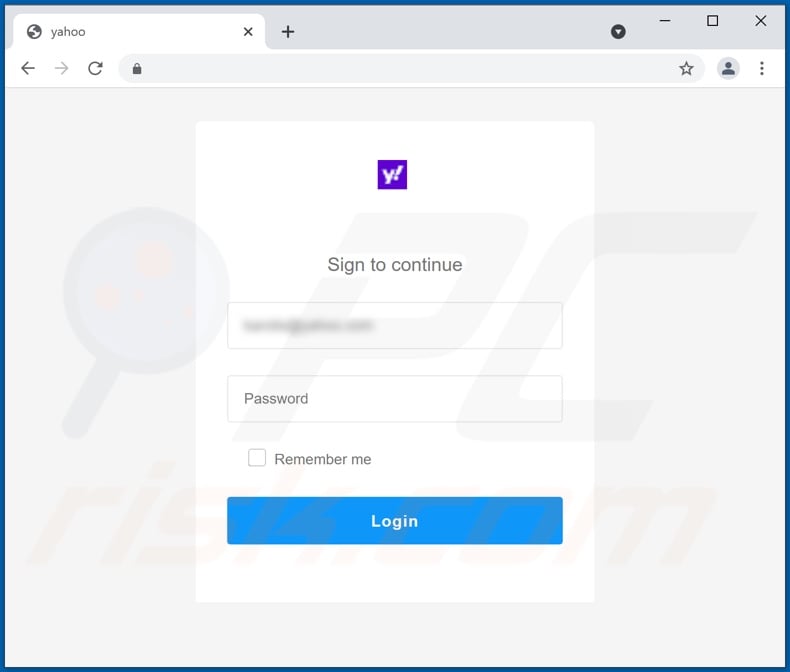
Another example of "We Noticed A Login From A Device You Don't Usually Use Email Scam"-themed email spam:
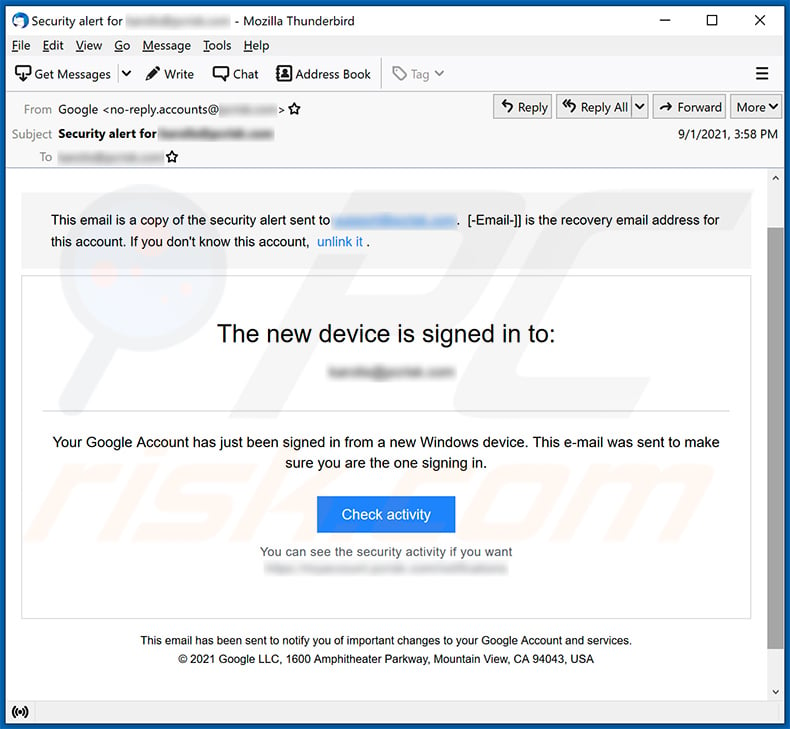
Text presented within:
Subject: Security alert for ********
This email is a copy of the security alert sent to ********. [-Email-]] is the recovery email address for this account. If you don't know this account, unlink it .
The new device is signed in to:
********
Your Google Account has just been signed in from a new Windows device. This e-mail was sent to make sure you are the one signing in.
Check activity
You can see the security activity if you want
********
This email has been sent to notify you of important changes to your Google Account and services.
© 2021 Google LLC, 1600 Amphitheater Parkway, Mountain View, CA 94043, USA
Screenshot of the promoted phishing site:
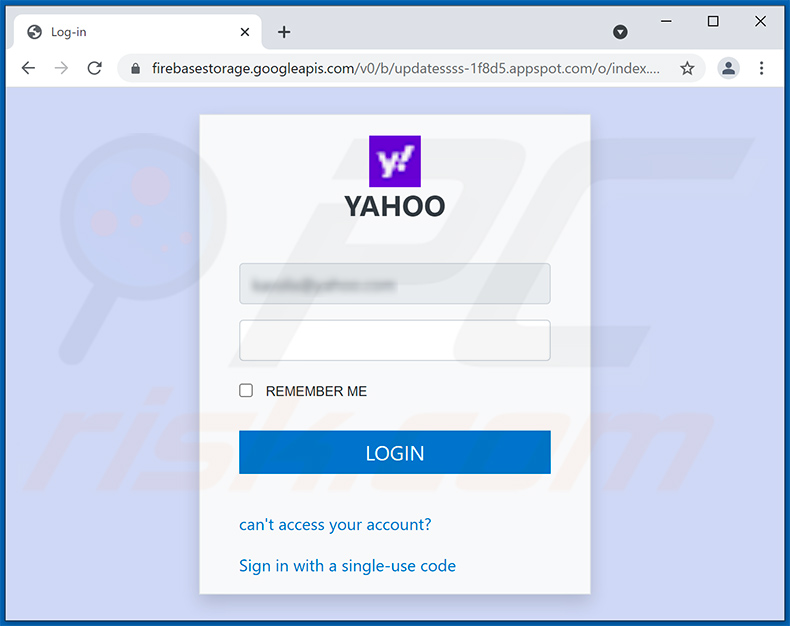
Another example of a login notification-themed spam email:
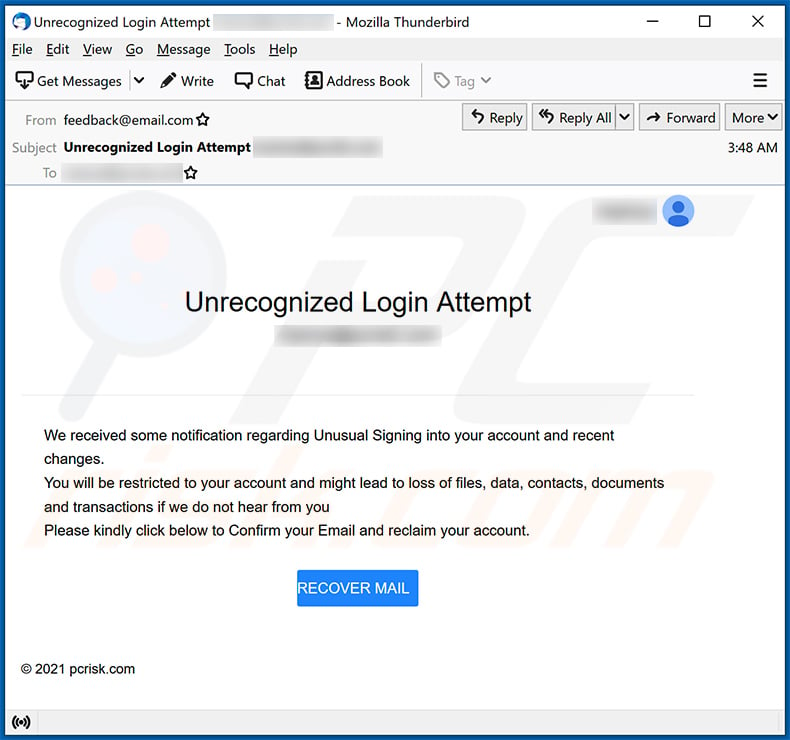
Text presented within:
Subject: Unrecognized Login Attempt ********
Unrecognized Login Attempt
********
We received some notification regarding Unusual Signing into your account and recent changes.
You will be restricted to your account and might lead to loss of files, data, contacts, documents and transactions if we do not hear from you
Please kindly click below to Confirm your Email and reclaim your account.
Recover Mail© 2021 ********
Another example of "We Noticed A Login From A Device You Don't Usually Use" spam email promoting a phishing site:
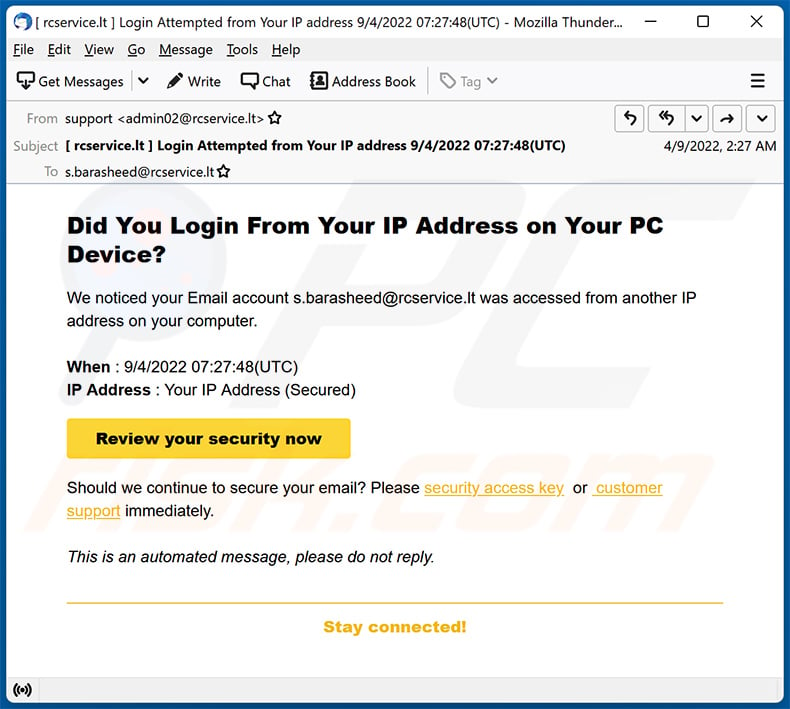
Text presented within:
Subject: [ - ] Login Attempted from Your IP address 9/4/2022 07:27:48(UTC)
Did You Login From Your IP Address on Your PC Device?
We noticed your Email account - was accessed from another IP address on your computer.When : 9/4/2022 07:27:48(UTC)
IP Address : Your IP Address (Secured)
Review your security now
Should we continue to secure your email? Please security access key or customer support immediately.This is an automated message, please do not reply.
Stay connected!
Screenshot of the promoted phishing site:
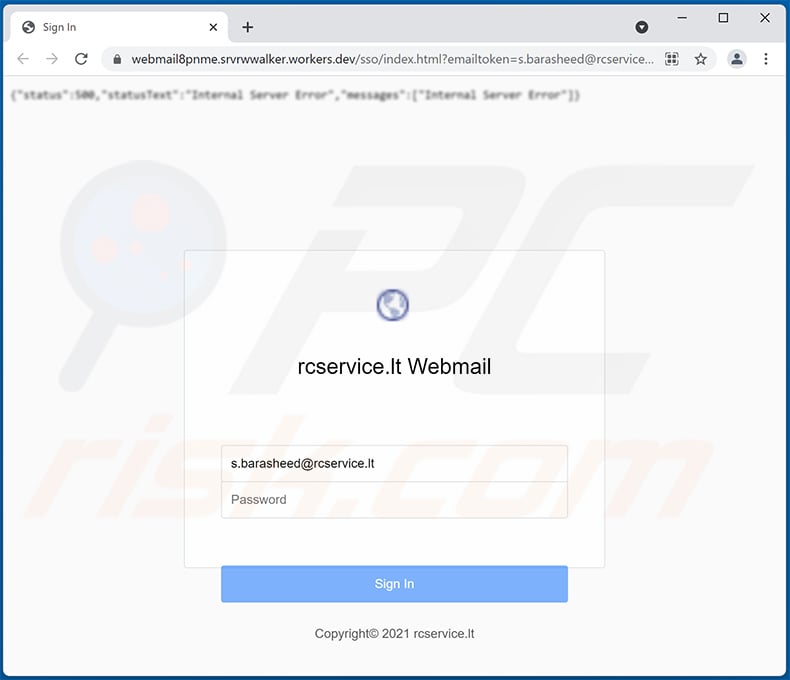
Another example of a new device login-themed spam email promoting a phishing site:
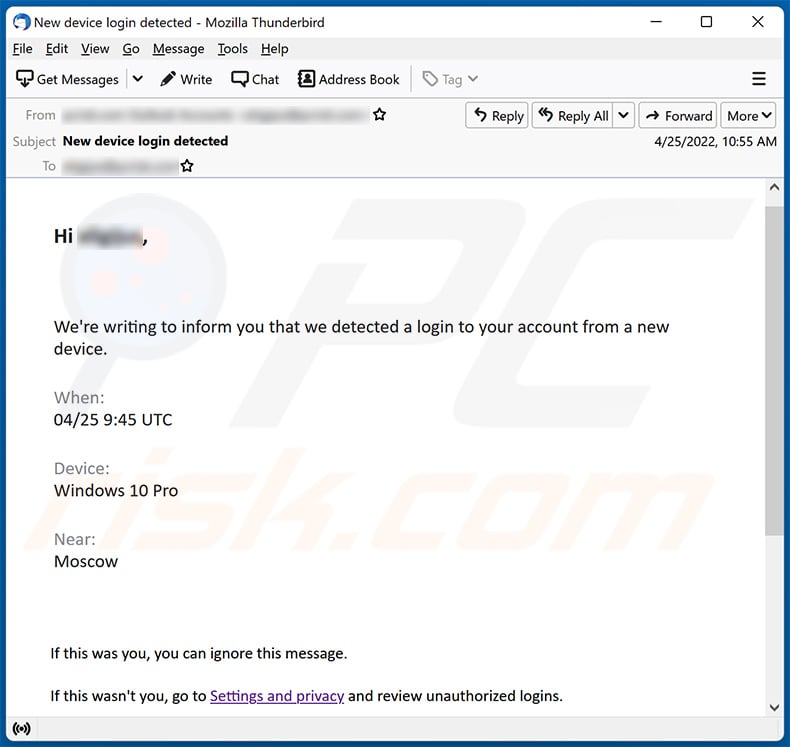
Text presented within:
Subject: New device login detected
Hi -,
We're writing to inform you that we detected a login to your account from a new device.
When: 04/25 9:45 UTC
Device: Windows 10 Pro
Near: Moscow
If this was you, you can ignore this message.
If this wasn't you, go to Settings and privacy and review unauthorized logins.
This is an automatically generated email.
Replies to this email address aren't monitored.This email was generated for -
Privacy Policy
Another example of "We Noticed A Login From A Device You Don't Usually Use" spam email promoting a phishing site:
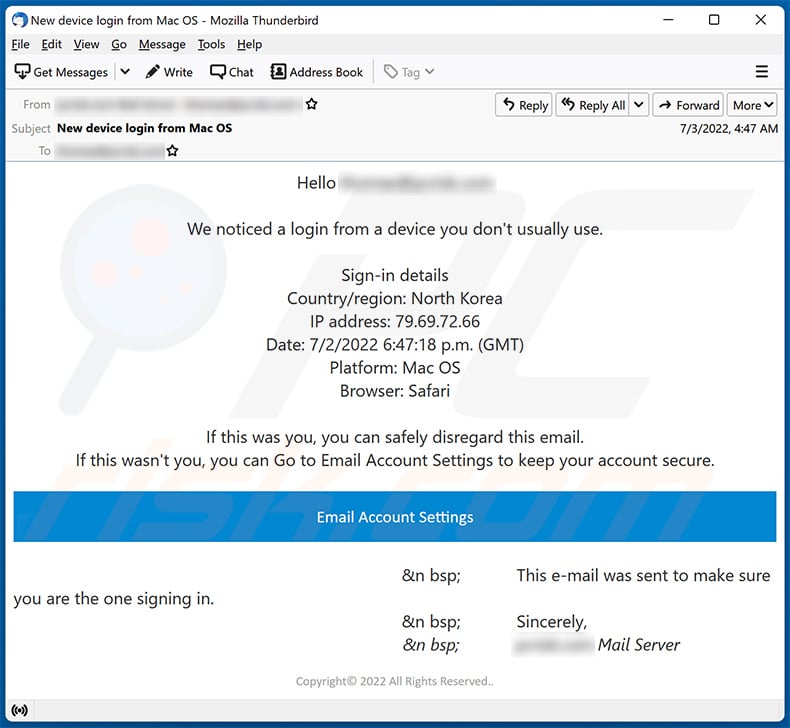
Text presented within:
Subject: New device login from Mac OS
Hello -
We noticed a login from a device you don't usually use.
Sign-in details
Country/region: North Korea
IP address: 79.69.72.66
Date: 7/2/2022 6:47:18 p.m. (GMT)
Platform: Mac OS
Browser: SafariIf this was you, you can safely disregard this email.
If this wasn't you, you can Go to Email Account Settings to keep your account secure.
Email Account SettingsThis e-mail was sent to make sure you are the one signing in.
Sincerely, - Mail Server
Copyright© 2022 All Rights Reserved..
Another example of an email from a similar spam campaign:
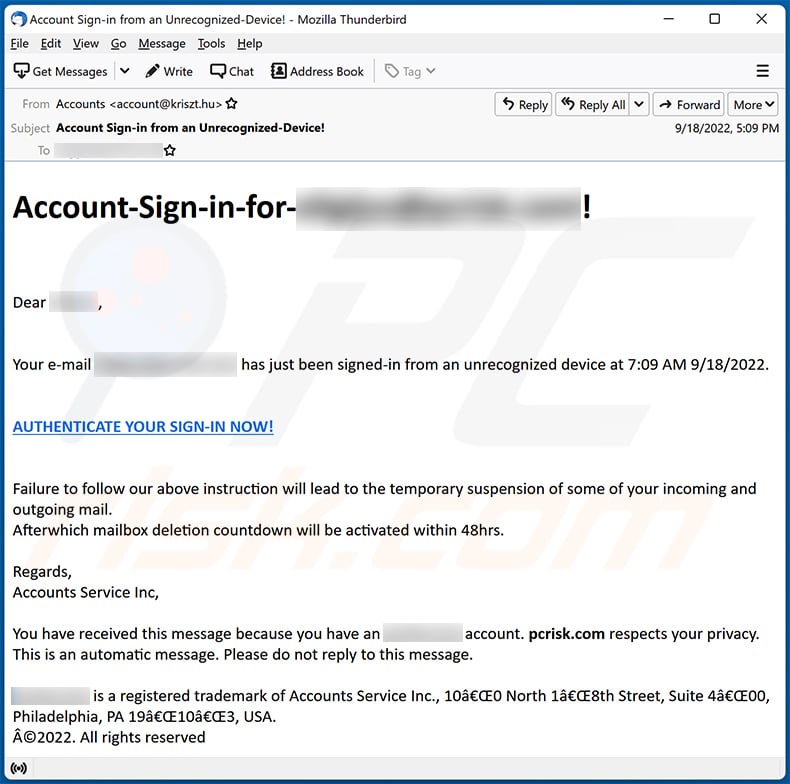
Text presented within:
Subject: Account Sign-in from an Unrecognized-Device!
Account-Sign-in-for--!
Dear -,Your e-mail - has just been signed-in from an unrecognized device at 7:09 AM 9/18/2022.
AUTHENTICATE YOUR SIGN-IN NOW!
Failure to follow our above instruction will lead to the temporary suspension of some of your incoming and outgoing mail.
Afterwhich mailbox deletion countdown will be activated within 48hrs.Regards,
Accounts Service Inc,You have received this message because you have an - account. - respects your privacy.
This is an automatic message. Please do not reply to this message.
Instant automatic malware removal:
Manual threat removal might be a lengthy and complicated process that requires advanced IT skills. Combo Cleaner is a professional automatic malware removal tool that is recommended to get rid of malware. Download it by clicking the button below:
DOWNLOAD Combo CleanerBy downloading any software listed on this website you agree to our Privacy Policy and Terms of Use. To use full-featured product, you have to purchase a license for Combo Cleaner. 7 days free trial available. Combo Cleaner is owned and operated by RCS LT, the parent company of PCRisk.com.
Quick menu:
- What is We Noticed A Login From A Device You Don't Usually Use spam?
- Types of malicious emails.
- How to spot a malicious email?
- What to do if you fell for an email scam?
Types of malicious emails:
![]() Phishing Emails
Phishing Emails
Most commonly, cybercriminals use deceptive emails to trick Internet users into giving away their sensitive private information, for example, login information for various online services, email accounts, or online banking information.
Such attacks are called phishing. In a phishing attack, cybercriminals usually send an email message with some popular service logo (for example, Microsoft, DHL, Amazon, Netflix), create urgency (wrong shipping address, expired password, etc.), and place a link which they hope their potential victims will click on.
After clicking the link presented in such email message, victims are redirected to a fake website that looks identical or extremely similar to the original one. Victims are then asked to enter their password, credit card details, or some other information that gets stolen by cybercriminals.
![]() Emails with Malicious Attachments
Emails with Malicious Attachments
Another popular attack vector is email spam with malicious attachments that infect users' computers with malware. Malicious attachments usually carry trojans that are capable of stealing passwords, banking information, and other sensitive information.
In such attacks, cybercriminals' main goal is to trick their potential victims into opening an infected email attachment. To achieve this goal, email messages usually talk about recently received invoices, faxes, or voice messages.
If a potential victim falls for the lure and opens the attachment, their computers get infected, and cybercriminals can collect a lot of sensitive information.
While it's a more complicated method to steal personal information (spam filters and antivirus programs usually detect such attempts), if successful, cybercriminals can get a much wider array of data and can collect information for a long period of time.
![]() Sextortion Emails
Sextortion Emails
This is a type of phishing. In this case, users receive an email claiming that a cybercriminal could access the webcam of the potential victim and has a video recording of one's masturbation.
To get rid of the video, victims are asked to pay a ransom (usually using Bitcoin or another cryptocurrency). Nevertheless, all of these claims are false - users who receive such emails should ignore and delete them.
How to spot a malicious email?
While cyber criminals try to make their lure emails look trustworthy, here are some things that you should look for when trying to spot a phishing email:
- Check the sender's ("from") email address: Hover your mouse over the "from" address and check if it's legitimate. For example, if you received an email from Microsoft, be sure to check if the email address is @microsoft.com and not something suspicious like @m1crosoft.com, @microsfot.com, @account-security-noreply.com, etc.
- Check for generic greetings: If the greeting in the email is "Dear user", "Dear @youremail.com", "Dear valued customer", this should raise suspiciousness. Most commonly, companies call you by your name. Lack of this information could signal a phishing attempt.
- Check the links in the email: Hover your mouse over the link presented in the email, if the link that appears seems suspicious, don't click it. For example, if you received an email from Microsoft and the link in the email shows that it will go to firebasestorage.googleapis.com/v0... you shouldn't trust it. It's best not to click any links in the emails but to visit the company website that sent you the email in the first place.
- Don't blindly trust email attachments: Most commonly, legitimate companies will ask you to log in to their website and to view any documents there; if you received an email with an attachment, it's a good idea to scan it with an antivirus application. Infected email attachments are a common attack vector used by cybercriminals.
To minimise the risk of opening phishing and malicious emails we recommend using Combo Cleaner Antivirus for Windows.
Example of a spam email:

What to do if you fell for an email scam?
- If you clicked on a link in a phishing email and entered your password - be sure to change your password as soon as possible. Usually, cybercriminals collect stolen credentials and then sell them to other groups that use them for malicious purposes. If you change your password in a timely manner, there's a chance that criminals won't have enough time to do any damage.
- If you entered your credit card information - contact your bank as soon as possible and explain the situation. There's a good chance that you will need to cancel your compromised credit card and get a new one.
- If you see any signs of identity theft - you should immediately contact the Federal Trade Commission. This institution will collect information about your situation and create a personal recovery plan.
- If you opened a malicious attachment - your computer is probably infected, you should scan it with a reputable antivirus application. For this purpose, we recommend using Combo Cleaner Antivirus for Windows.
- Help other Internet users - report phishing emails to Anti-Phishing Working Group, FBI’s Internet Crime Complaint Center, National Fraud Information Center and U.S. Department of Justice.
Frequently Asked Questions (FAQ)
Why did I receive this email?
Scam emails like this one are non-targeted. Scammers send the same email to all recipients.
I have provided my personal information when tricked by this email, what should I do?
If you have provided your login information on a phishing website promoted via this email, change your passwords as soon as possible. In other cases (if you have provided credit card details, ID card information, or other information), contact the corresponding authorities.
I have downloaded and opened a malicious file attached to an email, is my computer infected?
If you have opened an executable file, your computer is probably infected. Other files (e.g., MS Office documents) usually do not infect computers right after they are opened. Users infect computers after performing additional steps (e.g., enabling macros commands in malicious documents).
I have read the email but did not open the attachment, is my computer infected?
Emails cannot infect computers. Your computer is not infected if you have not opened a file or link presented in an email used to deliver malware.
Will Combo Cleaner remove malware infections that were present in email attachment?
Yes, Combo Cleaner will eliminate malware from the operating system. It can detect almost all known malware. Computers infected with high-end malware must be scanned using a full system scan since malware of this kind may hide deep in the system.
Share:

Tomas Meskauskas
Expert security researcher, professional malware analyst
I am passionate about computer security and technology. I have an experience of over 10 years working in various companies related to computer technical issue solving and Internet security. I have been working as an author and editor for pcrisk.com since 2010. Follow me on Twitter and LinkedIn to stay informed about the latest online security threats.
PCrisk security portal is brought by a company RCS LT.
Joined forces of security researchers help educate computer users about the latest online security threats. More information about the company RCS LT.
Our malware removal guides are free. However, if you want to support us you can send us a donation.
DonatePCrisk security portal is brought by a company RCS LT.
Joined forces of security researchers help educate computer users about the latest online security threats. More information about the company RCS LT.
Our malware removal guides are free. However, if you want to support us you can send us a donation.
Donate
▼ Show Discussion